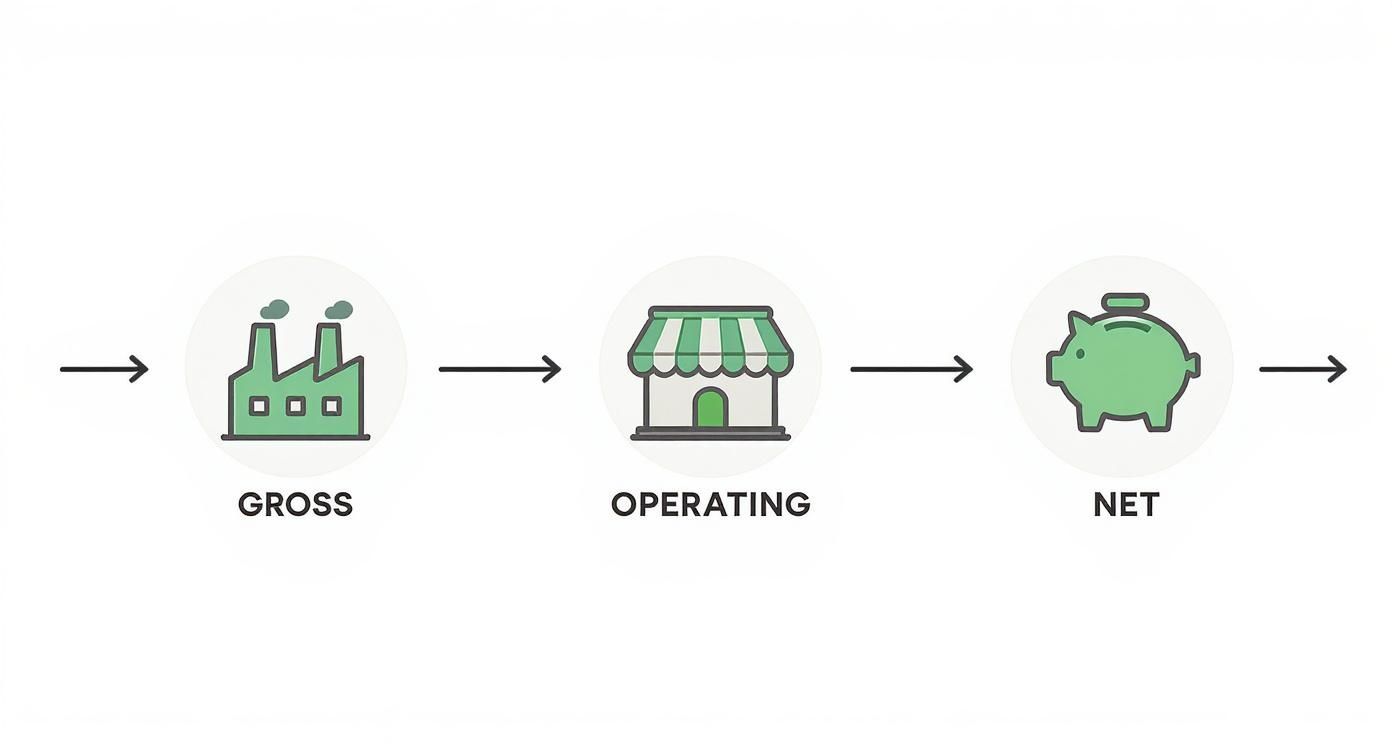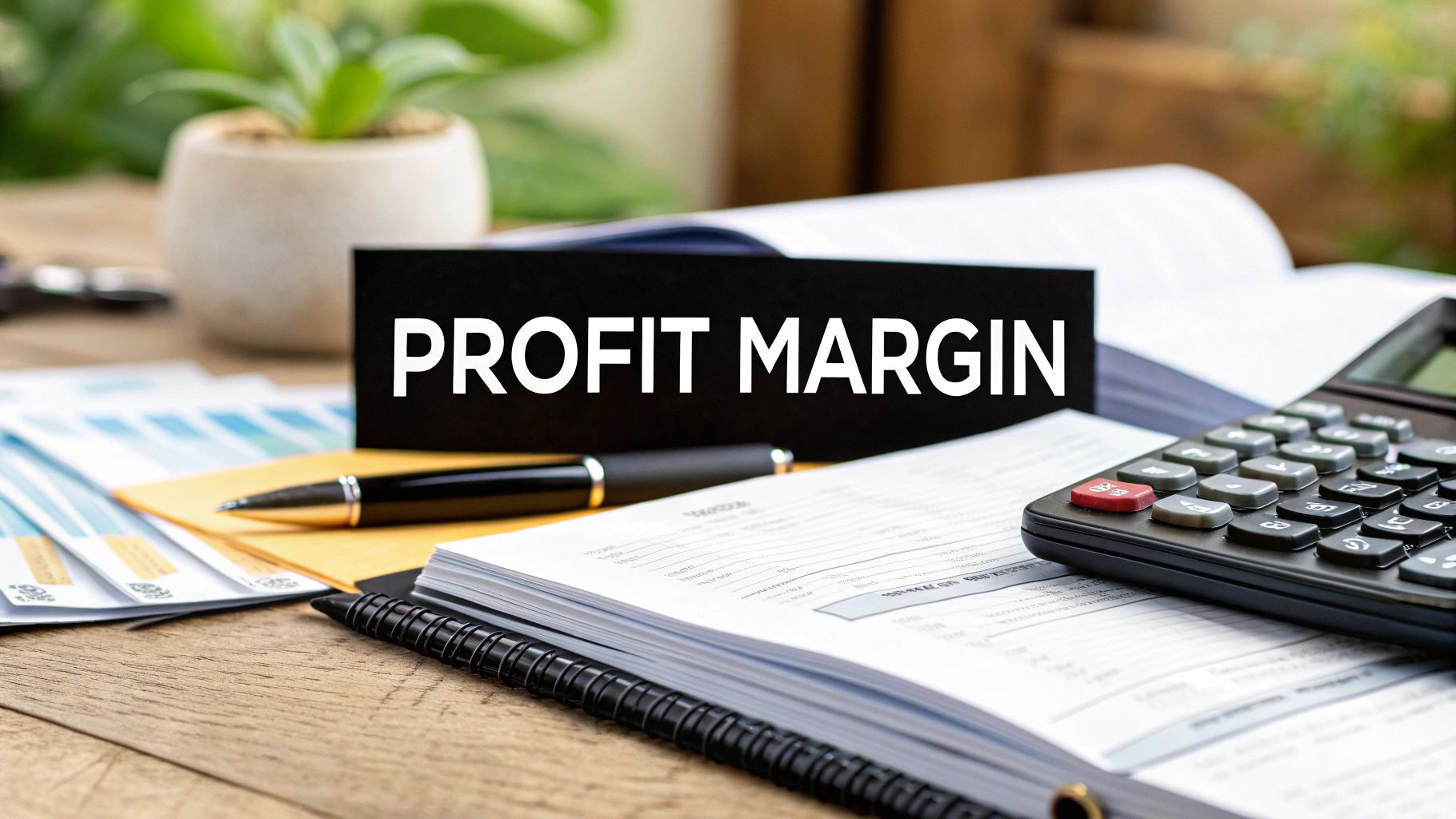Figuring out your profit margin is pretty simple on the surface. You just take your profit, divide it by your revenue, and then multiply that number by 100 to get a percentage.
This one number tells you exactly how much cash your business actually pockets for every single dollar it brings in. For any small business owner or entrepreneur, it's one of the most vital signs of your company's health and the cornerstone of a solid business plan.
Taking Your Business’s Financial Pulse
If you're running a small business, getting a handle on your profit margin isn't just some boring accounting chore—it’s the very pulse of your business plan. It’s the metric that tells you if your pricing strategy is working, if your costs are in check, and ultimately, if your business model is built to last.
Honestly, without a solid grasp of your margins, you're just guessing. You can't make smart calls on your marketing plan, operational spending, or how to grow if you don't know how much you're really making.
This is why we need to look at the three main types of profit margins. Each one peels back a different layer of your financial story, providing critical insights for any entrepreneur.
The infographic below really helps visualize how you go from basic production efficiency all the way to total profitability.

As you can see, each calculation builds on the one before it, giving you a progressively clearer picture of how your small business is actually doing.
The Three Pillars of Profitability
To get the full story of your company's financial health, you have to look at these three distinct metrics. Each one provides a unique insight for your business plan.
-
Gross Profit Margin: This is your first stop. It looks purely at the profitability of your products or services, stripping out all the other overhead and operational costs. It answers the fundamental question for any business model: "Am I making money on the stuff I sell?"
-
Operating Profit Margin: This one goes a step deeper. It tells you how well your core business is running by factoring in expenses like your marketing plan, rent, and salaries. It reveals the profit you're generating from your day-to-day activities.
-
Net Profit Margin: This is the big one—the bottom line. After every single expense is paid, from taxes to interest on loans, this percentage is what’s left in your pocket. It's the truest measure of your small business's success.
To give you a quick reference, here’s a simple table breaking down the three key profit margins.
The Three Key Profit Margins at a Glance
| Margin Type | Formula | What It Measures |
|---|---|---|
| Gross Profit Margin | (Revenue – COGS) / Revenue | Profitability of individual products/services. |
| Operating Profit Margin | (Revenue – COGS – Operating Expenses) / Revenue | Efficiency of core business operations. |
| Net Profit Margin | (Net Income) / Revenue | Overall profitability after all expenses. |
Getting a feel for these differences is absolutely critical for making smart decisions as a small entrepreneur. If you're looking for an even more detailed breakdown, check out this a comprehensive guide to calculating profit margins.
It's also super helpful to have a benchmark. Historically, the average U.S. corporate profit margin after tax has been around 9.43%, but this number can swing wildly depending on your industry. Knowing where you stand is a key part of putting together a solid feasibility study for your new business venture.
Calculating Gross Profit Margin for Production Efficiency
Think of your gross profit margin as the first, most crucial health check for your business model. It tells you a simple, powerful story: how good are you at turning your raw materials and labor into something people want to buy, profitably?
This number cuts right to the heart of your business plan, showing you the profit you’ve made after subtracting the direct costs of producing your goods or services—what’s known as the Cost of Goods Sold (COGS).
For any small business, from a freelance consultant to a local coffee roaster, getting a handle on this metric is non-negotiable. A healthy gross margin is the foundation everything else is built on. It’s the money you’ll use to pay for your marketing plan, rent, salaries, and, hopefully, yourself.

Unpacking the Formula and COGS
The formula itself looks straightforward, but its power lies in its simplicity.
Gross Profit Margin = [(Total Revenue – COGS) / Total Revenue] x 100
Total Revenue is easy enough—it’s all the money you generated from sales. The real trick, and where I see a lot of new entrepreneurs stumble, is pinning down your COGS. These are only the direct costs tied to creating what you sell.
Let's break it down with a couple of real-world small business scenarios:
- Product-Based Business (like a bakery): Your COGS would be the cost of flour, sugar, butter, and packaging. It also includes the wages of the bakers who are physically making the croissants and cakes. This is a classic manufacturing business model.
- Service-Based Business (like a marketing agency): This is a bit different. For this business model, COGS might be the cost of a specific analytics software you need to deliver a report to a client, or the hourly wage of a contractor you brought on for a particular project.
Getting your COGS right is everything. If you want to see a detailed breakdown in a real business plan, check out the financials in our sample bakery business plan.
What Is a Good Gross Margin?
So, what's a "good" number to aim for? The honest answer is: it depends on your business model. A lot.
Industry averages are all over the place. An S&P 500 analysis found the average gross profit margin to be around 43%, with the 2022 figure climbing to 45%. But that’s just a blended average.
A software company might easily hit an 80% margin, while a small retail shop could be thriving at 35%. The key for any small entrepreneur is to stop comparing yourself to everyone and start looking at benchmarks for your specific industry. Dig into some research on sites like einvestingforbeginners.com to find realistic targets for your business plan.
Here’s the bottom line: a consistently dropping gross margin is a serious warning sign. It’s your business telling you that either your supplier costs are creeping up or your pricing has fallen out of sync with the market. You need to act.
Time for a Reality Check: Your Operating Margin

If gross margin tells you how profitable your product is, operating margin tells you how profitable your actual business is. Think of it as your operational report card—it shows just how well your day-to-day activities are turning revenue into real, spendable profit. It's a true measure of your business model's efficiency.
Before you can get there, you need a handle on your operating expenses (OpEx). These are all the costs you incur just to keep the lights on, even if they aren't directly tied to creating the thing you sell.
We're talking about salaries, office rent, the costs from your marketing plan, software subscriptions—the works. These costs are the engine of your business, and your operating margin tells you how fuel-efficient that engine really is.
The Nitty-Gritty: How to Calculate Operating Margin
The formula is pretty straightforward and builds right on the gross profit figure you've already figured out. You're just adding one more layer of costs.
Operating Profit Margin = (Operating Income / Total Revenue) x 100
And to get your Operating Income, you just need this: Revenue – COGS – Operating Expenses.
This number is absolutely critical, especially if you're writing a business plan or looking for funding. It shows investors and lenders that you don't just have a great idea; you have a sustainable, well-run machine for bringing it to market. They want to see that you've mastered your operational costs, and this metric proves it.
Let's go back to our freelance marketing consultant, a common small entrepreneur business model. Their monthly revenue is $10,000 and their COGS are $1,500, giving them a gross profit of $8,500.
Now, let's tally up their OpEx for the month:
- Software (CRM, analytics tools): $300
- Marketing & ads (part of their marketing plan): $500
- Home office stipend: $200
- Professional insurance: $100
That brings their total OpEx to $1,100. This means their operating income is $8,500 (Gross Profit) – $1,100 (OpEx) = $7,400.
Let's plug that into the formula:
($7,400 / $10,000) x 100 = 74%
Frankly, an operating margin of 74% is fantastic for a service-based small business. It screams "lean and mean." For a small business owner, a number like this means you have cash to reinvest in growth, weather unexpected storms, or simply pay yourself more. It’s a powerful sign that your business model is not just surviving, but built to thrive.
Finding Your Net Profit Margin: The Bottom Line
This is it—the ultimate financial report card for your small business. Net profit margin cuts through all the noise to show you the final, unvarnished truth of your profitability. It answers the one question every entrepreneur obsesses over: after every single bill is paid—from materials and marketing to interest and taxes—how much of each dollar in revenue do you actually get to keep?
For investors, lenders, and especially for yourself, this metric is the definitive measure of a healthy, sustainable business. A strong net margin doesn't just prove your business model is viable; it proves it's efficient from top to bottom. It shows you've got a solid handle on your pricing, your operational spending, and all your financial obligations—key components of any winning business plan.
The Final Calculation
The formula here is the most comprehensive of the three, because it has to account for every single expense your business has.
Net Profit Margin = (Net Income / Total Revenue) x 100
Your Net Income is what’s left after all expenses—COGS, operating costs, interest on loans, and taxes—are subtracted from your total revenue. There's a reason they call it the "bottom line."
A lot of entrepreneurs accidentally create a misleading picture of their financial health by forgetting about one-off costs or underestimating their tax burden. You have to be meticulous here. Every single expense needs to be included to get a true reading of your small business's pulse.
One of the most common pitfalls I see with small business owners is overlooking non-operational costs. Things like the interest payments on a business loan or a one-time equipment repair are easy to forget, but they're absolutely critical for an accurate net profit calculation. My advice? Always review your entire expense ledger, not just the usual suspects.
Benchmarking Your Business Success
So, what’s a “good” number to aim for? This is where it gets tricky, because net profit margins vary wildly across different business models. Looking at global data from NYU Stern, the average net margin across all industries is roughly 8.54%.
But averages can be deceiving. A retail business might average around 4.88%, while a high-margin field like semiconductors can hit 18.21%. Knowing these benchmarks is vital for setting realistic goals in your business plan and seeing how you stack up against the competition.
To give you a clearer picture, here’s a quick look at what you can typically expect in common small business sectors.
Average Net Profit Margins for Small Businesses by Sector
This table provides a handy reference for typical net profit margin benchmarks across various industries. It's a great way for an entrepreneur to gauge performance.
| Industry Sector | Average Net Profit Margin Range |
|---|---|
| Restaurants & Food Service | 3% – 6% |
| Retail (General) | 2% – 5% |
| Consulting & Professional Services | 15% – 25% |
| Construction & Trades | 4% – 8% |
| Software & Tech Services | 15% – 30%+ |
Comparing your numbers to this table gives you that crucial outside perspective. It's the quickest way to see if you're leading the pack or if there's still room to tighten things up and boost your business model's efficiency.
Turning Profit Margin Insights into Business Growth
Knowing how to run the numbers on your profit margin is one thing. Actually using those insights to make your business better? That's where the real magic happens for an entrepreneur. For a small business owner, these percentages aren't just academic exercises—they're a direct report card on your business plan and a clear guide for your next move.
Each margin tells its own unique story and points you toward specific levers you can pull to strengthen your company. A weak margin isn't a sign of failure; it's a flashing light showing you exactly where to optimize your business model.
Boosting Your Gross Margin
If your gross profit margin isn't stacking up against your industry's average, the issue is rooted in either your production costs or your pricing strategy. This is your cue to get forensic with your cost of goods sold (COGS) and revenue streams.
First, pull out those supplier contracts. Can you get a better deal by committing to larger orders? Is there another vendor out there who could give you the same quality for less? Even a tiny 5% drop in what you pay for materials can give your gross margin a serious lift.
Next up is pricing. Take a hard look at what you’re charging. Does it truly reflect the value you’re delivering? Don't be shy about experimenting with small price bumps on some of your offerings. You'd be surprised how often customers will pay a little more for quality they trust, and that goes straight to your gross profit.
A healthy gross margin is the bedrock of a stable business. It’s your first line of financial defense, ensuring you have enough left over to handle all the other costs of being in business. Without it, your entire business plan gets shaky.
Improving Your Operating Margin
When your operating margin is thin, it's a clear sign that your day-to-day running costs are gobbling up too much of your profit. It’s time to get serious about operational efficiency and take a closer look at your marketing plan.
Here are a few places for a small entrepreneur to start:
- Audit Your Subscriptions: Go through every single software and service you pay for monthly. Are you really using them all? Ditch any tools that aren't adding obvious value.
- Optimize Marketing Spend: Is your marketing plan actually bringing in profitable customers? Analyze your campaigns, cut the ones that aren't performing, and pour that money into the channels that are.
- Embrace Automation: Pinpoint the repetitive, manual tasks that eat up your time. Automating them frees you up to focus on growth and cuts down on overhead, which is a direct boost to your operating efficiency.
Protecting Your Net Margin
Finally, the net margin. This is the ultimate measure of your small business's health after every single expense—including taxes and interest—has been paid. To keep this number healthy, you have to be smart about financial management.
This means thinking about taxes all year, not just scrambling when the deadline is looming. It also means managing any debt you have. High-interest loans are silent profit killers, so it’s always worth looking into refinancing if you can get a better rate. Protecting your net margin is what ensures the money you work so hard as an entrepreneur to make actually stays in your pocket.
For entrepreneurs getting started, building this solid foundation from the get-go is critical. You can get structured guidance with tools like the Growth-Grid AI Starter Pack to make sure your financial planning and business goals are in sync from day one.
Answering Your Top Profit Margin Questions

Even after you've got the formulas down, some questions about profit margins always seem to pop up for small business owners. It's completely normal. Let’s clear up a few of the most common ones I hear so you can use these numbers with confidence in your business planning.
What Is a Good Profit Margin for a Small Business?
This is the million-dollar question, but the honest answer is: it completely depends. There's no single magic number that works for every small entrepreneur.
A software company might be aiming for a 20% net profit margin or higher, while a local cafe or grocery store could be thriving with a margin as low as 2%. It all comes down to industry norms and business models.
So, instead of getting fixated on a universal number, focus your energy on two things:
- How do you stack up against your direct competitors? Look up industry average profit margins for your business model.
- Are you improving your own numbers over time? Consistent, steady growth is the real goal for any entrepreneur.
A "good" profit margin is one that covers all your bills, leaves enough to reinvest in the business, and rewards you for the risk and effort you're putting in. That's it.
How Often Should I Calculate My Profit Margin?
For the average small business, running the numbers on a quarterly basis is a great rhythm to get into. It gives you a regular financial pulse check for your business plan without bogging you down in constant analysis.
But, there's a big "if" here. If your business is highly seasonal (like a holiday-themed retail shop) or has a high-volume, low-margin business model, you'll want to switch to a monthly calculation. Doing this lets you catch any negative trends in your pricing or costs fast, before a small leak becomes a major flood.
One of the biggest traps for new entrepreneurs is confusing profit with cash. You can have a "profitable" month on paper but still not have enough cash in the bank to make payroll because your clients are slow to pay. Always, always watch your cash flow statement just as closely as your P&L.
Ready to build a business plan with financial projections that make sense? GrowthGrid uses AI to help you put together a detailed, professional plan in less than 15 minutes, making sure your profit margin goals are backed by solid data. Get started with GrowthGrid today!
